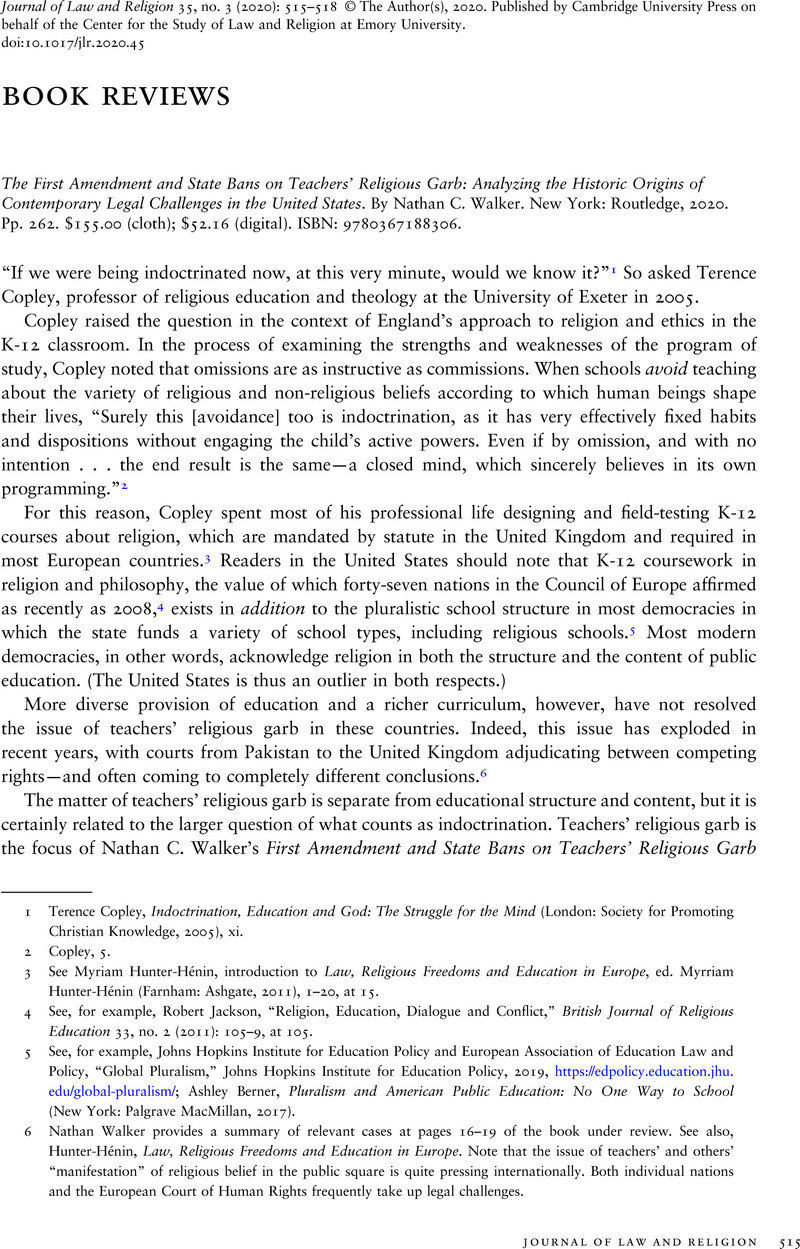No CrossRef data available.
Article contents
The First Amendment and State Bans on Teachers’ Religious Garb: Analyzing the Historic Origins of Contemporary Legal Challenges in the United States. By Nathan C. Walker. New York: Routledge, 2020. Pp. 262. $155.00 (cloth); $52.16 (digital). ISBN: 9780367188306.
Published online by Cambridge University Press: 28 December 2020
Abstract

- Type
- Book Review
- Information
- Copyright
- Copyright © The Author(s), 2020. Published by Cambridge University Press on behalf of the Center for the Study of Law and Religion at Emory University.
References
1 Copley, Terence, Indoctrination, Education and God: The Struggle for the Mind (London: Society for Promoting Christian Knowledge, 2005), xiGoogle Scholar.
2 Copley, 5.
3 See Hunter-Hénin, Myriam, introduction to Law, Religious Freedoms and Education in Europe, ed. Hunter-Hénin, Myrriam (Farnham: Ashgate, 2011), 1–20Google Scholar, at 15.
4 See, for example, Jackson, Robert, “Religion, Education, Dialogue and Conflict,” British Journal of Religious Education 33, no. 2 (2011): 105–9CrossRefGoogle Scholar, at 105.
5 See, for example, Johns Hopkins Institute for Education Policy and European Association of Education Law and Policy, “Global Pluralism,” Johns Hopkins Institute for Education Policy, 2019, https://edpolicy.education.jhu.edu/global-pluralism/; Berner, Ashley, Pluralism and American Public Education: No One Way to School (New York: Palgrave MacMillan, 2017)CrossRefGoogle Scholar.
6 Nathan Walker provides a summary of relevant cases at pages 16–19 of the book under review. See also, Hunter-Hénin, Law, Religious Freedoms and Education in Europe. Note that the issue of teachers’ and others’ “manifestation” of religious belief in the public square is quite pressing internationally. Both individual nations and the European Court of Human Rights frequently take up legal challenges.
7 See a brief summary of national statistics and data from classrooms in Ashley Berner, “In a Polarized America, What Can We Do about Civil Disagreement?,” Brown Center Chalkboard (blog), April 10, 2020, https://www.brookings.edu/blog/brown-center-chalkboard/2020/04/10/in-a-polarized-america-what-can-we-do-about-civil-disagreement/.
8 There are too many excellent sources to name in a footnote. But for a start, see Glenn, Charles Leslie, The Myth of the Common School (Amherst: University of Massachusetts Press, 1988)Google Scholar; Hamburger, Philip, Separation of Church and State (Cambridge, MA: Harvard University Press, 2002)Google Scholar.
9 See, for example, Prothero, Stephen, Religious Literacy: What Every American Needs to Know—And Doesn't (New York: HarperCollins, 2007)Google Scholar.
10 “Democratic deliberation” is one of the goods valued by educational theorist Amy Gutmann, currently president of the University of Pennsylvania. See Gutmann, Amy, Democratic Education (Princeton: Princeton University Press, 1987)Google Scholar; Gutmann, Amy, Democratic Education: With a New Preface and Epilogue (Princeton: Princeton University Press, 1999)CrossRefGoogle Scholar; Gutmann, Amy, Democratic Education, rev. ed. (Princeton: Princeton University Press, 2001)Google Scholar.





